2022 Lee Kong Chian Distinguished Professors
Our eminent speaker, Prof Virginijus Siksnys, is the 2018 Kavli Prize laureate in Nanoscience and the chief scientist and head of the Department of Protein-Nucleic Acids Interactions at the Vilnius University Institute of Biotechnology.
Held on 26 August 2022 at the Tan Chin Tuan Lecture Theatre, the lecture by Prof Siksnys was sponsored by the Lee Foundation and it was well attended by around 200 attendees, both online and in-person. We would also like to thank the Ministry of Education Curriculum Planning and Development Division for helping to disseminate the event publicity to the pre-university teachers and students.
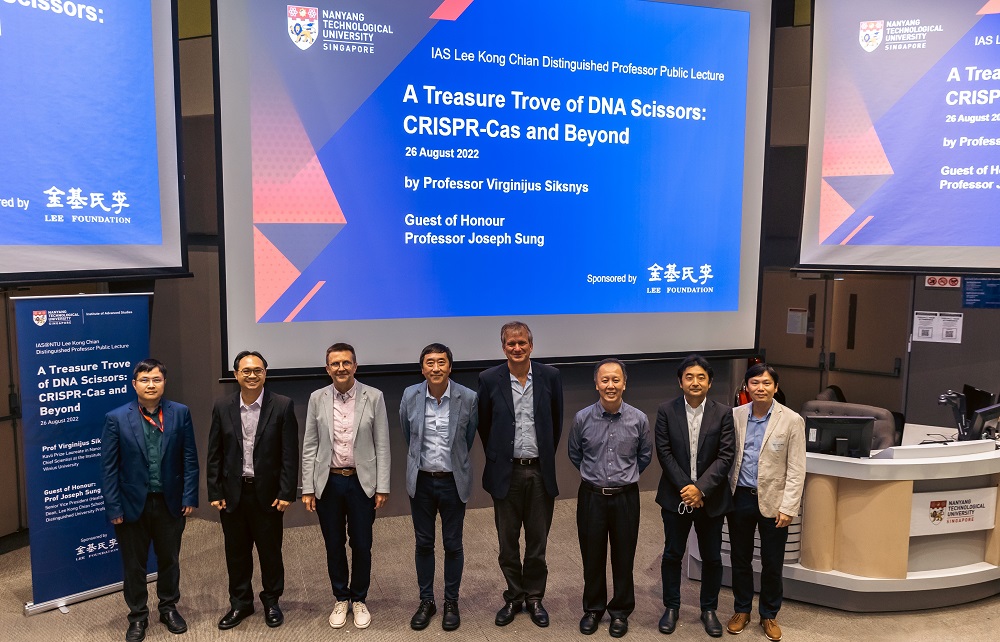
[From left] Prof Tan Meng How (Assoc Chair, Students & Continuing Education, CCEB), Prof Sum Tze Chien (Director, IAS), Prof Virginijus Syksnys, Prof Joseph Sung (Dean, LKCMedicine), Prof Peter Preiser (Assoc Vice President, Biomedical & Life Sciences), Prof Lim Kah Leong (Vice-Dean, Research, LKCMedicine), Prof Shunsuke Chiba (Acting Co-Chair, CCEB) and Prof Chen Peng (Assoc Chair, Faculty, CCEB).
Before the lecture began, IAS Director Prof Sum Tze Chien gave a welcome address followed by opening remarks from the Guest of Honour Prof Joseph Sung.
The talk's title "A Treasure Trove of DNA Scissors: CRISPR-Cas and beyond" makes reference to Prof Siksnys' comparison of his Kavli Prize winning discovery of DNA cutting protein CRISPR-Cas 9 to a pair of scissors. In 2007, Prof Siksnys came across a paper in the Science journal that described CRISPR in Streptococcus thermophilus bacteria found in cheese and yoghurt. This piqued his curiosity and led him to start studying the structure and properties of the CRISPR system. Among his earliest discoveres, he found that Cas9 endonuclease could be readily re-programmed to cleave any target site in the genome at low cost. These results were published in PNAS in 2012, which heralded a new era of DNA editing technology. According to Prof Siksnys, the time before 2012 can be called “BC” (i.e., “Before Cas9”), while the period after 2012 can be called "AC" (i.e., “After Cas9 period”).
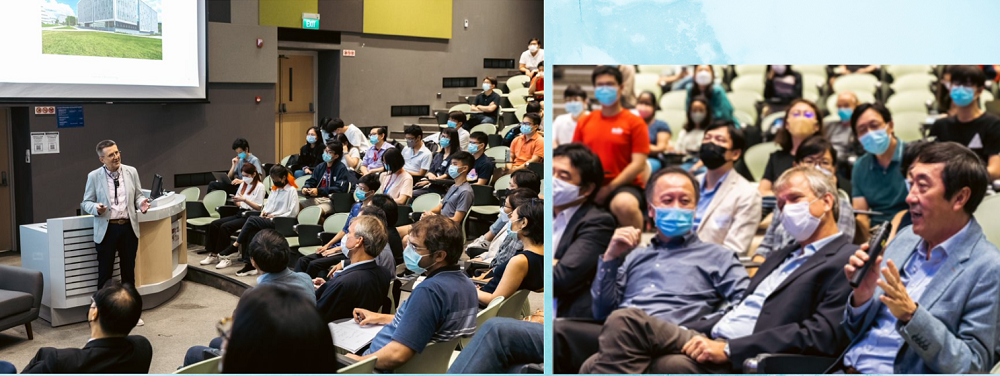 Prof Joseph Sung (far right) posing a question at the Q&A.
Prof Joseph Sung (far right) posing a question at the Q&A.
After the discovery and success of Cas9, Prof Siksnys’ group started looking into other Cas enzymes that could function as alternative pairs of scissors. He found that several Cas12f nucleases were active in eukaryotic cells and could be readily programmed to cleave double stranded DNA in a similar manner as Cas9. Importantly, Cas12f is much smaller than Cas9, which would be advantageous in delivery.
Even after finding two state-of-the-art programmable DNA cleaving enzymes, Prof Siksnys’ quest of finding better alternatives for genome editing did not end. This was when he started looking into ISDra2 transposition by a TnpB protein, which belongs to 15200/605 family of transposons. In his work, he found a Transposon Associated Motif (TAM), TTGAT, that was characteristic of both TnpB and TnpA transposons. Further research into the properties and structure of these transposons led to the discovery of novel RNA guided genome editing capabilities of TnpB. Comparing TnpB with Cas9 and Cas12f based on their properties, Prof Syksnys said, “I have three tools in my genome editing toolbox: Cas9 - the biggest scissors, Cas12f - the medium sized scissors, and TnpB - the smallest scissors. I am hopeful that the CRISPR toolbox can do amazing things for gene therapy in the future.”
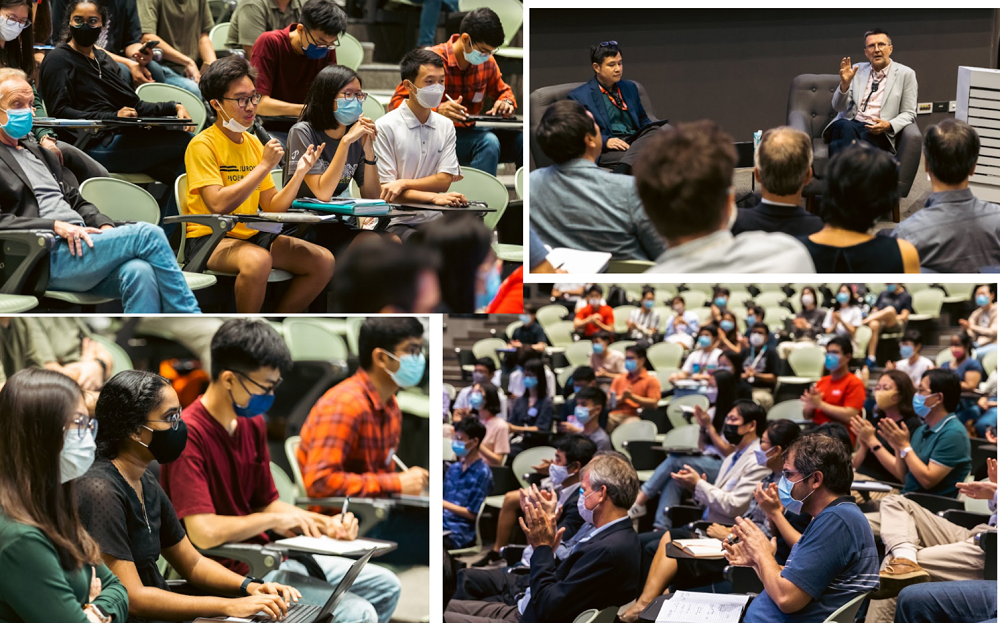 Enthusiastic participants engrossed in the Q&A session with Prof Syksynys.
Enthusiastic participants engrossed in the Q&A session with Prof Syksynys.
In the Q&A session that followed, there were some intriguing questions, such as the feasibility of using Cas9 in human disease medication. Prof Siksnys gave an example of an ex-vivo approach, where the bone marrow was taken out of the patient and treated before being put back in to produce healthy blood cells which can travel across the human body. Prof Siksnys highlighted that while curing a disease in the human body may still be difficult with current technologies, future technologies in development can prove very useful. Researchers are also raising genetically modified pigs, which can be used to donate organs to humans in need of organ replacement to curb the issue of lack of organ donors.
In response to further questions regarding preparation, practices and work required to reach the pinnacle of research and development in the sciences, Prof Siksnys said, “Do what motivates you, what keeps you awake, if it is passion for sciences, you will reach there one day. You won’t learn until you are ready to make many mistakes. After all, science is just about moving from one mistake to another.”
Pritish Mishra | PhD student, Interdisciplinary Graduate Program, NTU
Our keynoted speakers, Nobel Laureates Prof Konstantin Novoselov and Prof Brian Schmidt, were appointed as Lee Kong Chian Distinguished Professors in relation to the centennial conference.
The hybrid conference was held on 8 June 2022 at the NTU Nanyang Auditorium in honour of Prof CN Yang’s pioneering and lifelong contributions to physics and education on the occasion of his 100th Birthday. Prof Yang, Nobel Laureate in Physics 1957, has made significant contributions to theoretical physics, ranging from particle physics, quantum field theory to statistical mechanics and condensed matter theory. He has always been a fervent supporter of education, and he has maintained strong links with NTU Singapore since the time of its predecessor institution, Nanyang University. The CN Yang Scholars Programme, one of the Premier Scholars Programmes in NTU, which nurtures talented undergraduates who have a passion for science and technology, was launched in 2006 and it was named after him.
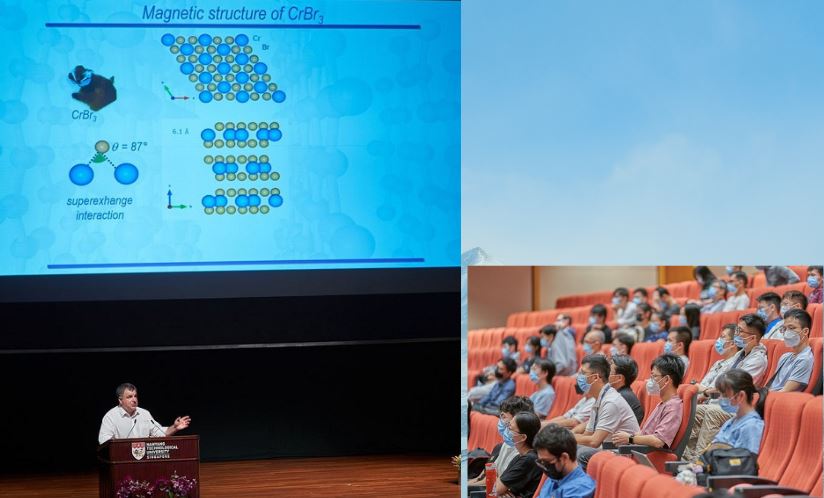 Prof Konstantin Novoselov delivering his talk to an engaging audience.
Prof Konstantin Novoselov delivering his talk to an engaging audience.
In the keynote talk "Materials for the Future" by Prof Konstantin Novoselov (Nobel Laureate in Physics 2010; National University of Singapore), he sharing about the applications of physics in materials, such as graphite, and engineering was highly enriching for all participants regardless of educational background through the referencing of everyday concepts. He also cited the movie, “Terminator 2” (1991), to discuss how bottom-up functionality at the material and structural level was depicted to be the near future in the film, while we are currently still at top-down functionality at the structural level.
Another keynote talk was delivered by Prof Brian Schmidt (Nobel Laureate in Physics 2011; Australian National University) online. Titled "The Evolution of Physics in the 100 Years of Prof CN Yang", Prof Schmidt summarised the history of modern physics and his research field of cosmology, and also shared the great influence of Yang-Mills Theory. As Prof Schmidt mentioned, Prof Yang has lived through the start of all modern physics. Prof Schmidt also mentioned how computational approaches are allowing us to make revolutionary advances - and this surely applies to many other fields in STEM. He ended his presentation with words of advice for aspiring scientists, “The research journey is tough, but passion will guide you through it”.
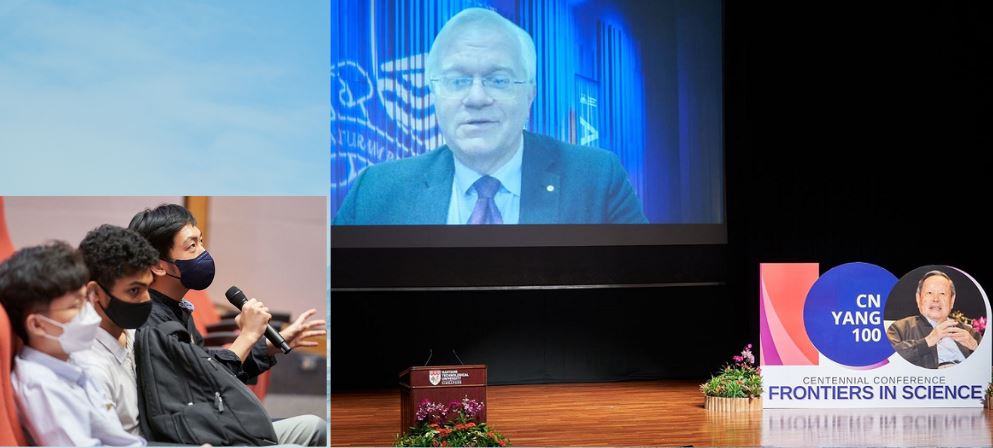 Prof Brian Schmidt delivering his online talk "The Evolution of Physics in the 100 Years of Professor CN Yang" from Australia.
Prof Brian Schmidt delivering his online talk "The Evolution of Physics in the 100 Years of Professor CN Yang" from Australia.
The conference was attended by 185 in-person participants and over 300 participants across the globe virtually. Majority of the participants were students, researchers and faculty members, as well as some high school students.
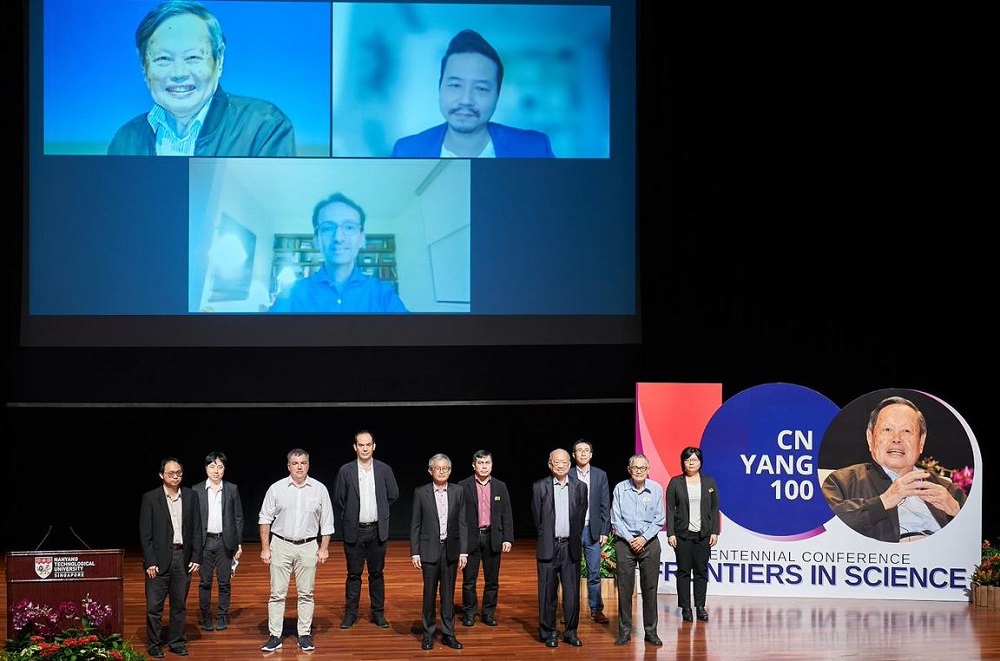 [On stage, from left] Prof Sum Tze Chien, Assoc Prof Gu Mile, Prof Konstantin Novoselov, Assoc Prof David Wilkowski, Prof Ling San, Assoc Prof Ariando, Prof Phua Kok Khoo, Prof Fan Hongjin, Prof Oh Choo Hiap and Nanyang Asst Prof Nelly Ng
[On stage, from left] Prof Sum Tze Chien, Assoc Prof Gu Mile, Prof Konstantin Novoselov, Assoc Prof David Wilkowski, Prof Ling San, Assoc Prof Ariando, Prof Phua Kok Khoo, Prof Fan Hongjin, Prof Oh Choo Hiap and Nanyang Asst Prof Nelly Ng
[On screen, from left clockwise] Prof CN Yang (photograph), Assoc Prof Tan Meng Chwan and Prof Christos Panagopoulos

Our distinguished speaker, Nobel Laureate Prof Didier Queloz, is the Jacksonian Professor of Natural Philosophy in the Cavendish Laboratory and the Director of Leverhulme Centre for Life in the Universe at the University of Cambridge.
The hybrid format public lecture, held on 21 April 2022 at the Nanyang Auditorium, was organised by the College of Science and the Institute of Advanced Studies at NTU with support from the Lee Foundation and Ms Alice Hung, Founder of Paeonia Ventures. The public lecture was well-attended by 430 participants and as many as 225 participants joined virtually across the globe. Majority of the participants were students from diverse educational backgrounds, including many high school students.
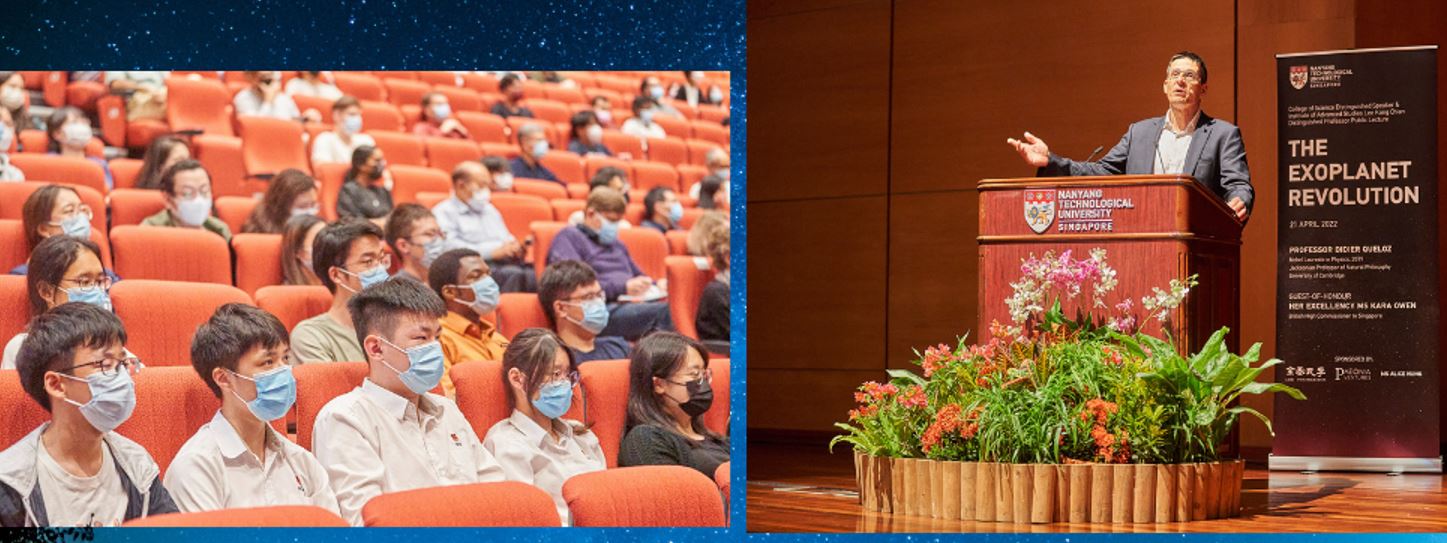
Prof Queloz's lecture preceded a welcome address from Prof Subra Suresh, President, NTU, and an opening remarks by the Guest-of-Honor Her Excellency Ms Kara Owen, the British High Commissioner to Singapore.
Prof Didier Queloz addressed the questions concerning the origin of planets, their structure and ingredients required to make a planet capable of supporting life. Taking the example of planets from our solar system, he started with a brief discussion on the classical planetary theories, which for many decades were believed could provide insight into the location and the size of a planet. However, in 1995, he obtained the novel results concerning the first extrasolar exoplanet relying on the advanced equipment he built. The results challenged the then existent planetary theories, and later led to the “Exoplanet Revolution” through the discovery of many more planets. Till date, about five-thousand exoplanets have been discovered.
Since the important question is about finding an Earth-equivalent, he made a comparison of all the known exoplanets with the Earth in terms of parameters like mass, radii, density and period. His studies provides an estimate about the probability of finding a planet with a particular mass and size; and which planets are actually similar to our home-planet Earth in terms of the quantities mentioned earlier suggesting that they might have same composition. His talk described the signatures of geological and biological evolution of planets and underlined the criteria governing the habitability of these planets.
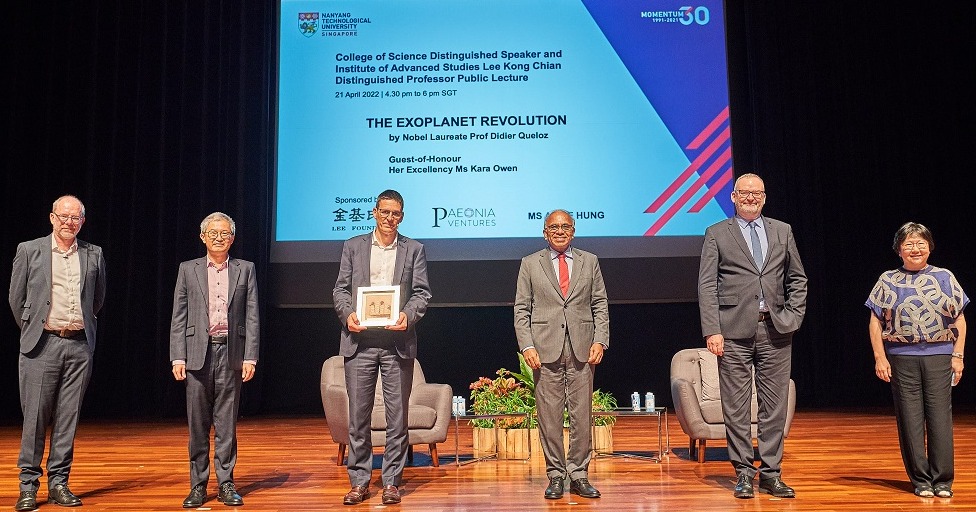 [From left] Prof Simon Redfern (Dean, NTU College of Science), Prof Ling San (NTU Deputy President and Provost ), Nobel Laureate Prof Didier Queloz, Prof Subra Suresh (NTU President), His Excellency Mr Fabrice Filliez (Ambassador of Switzerland to Singapore), and Ms Alice Hung (Founder of Paeonia Ventures)
[From left] Prof Simon Redfern (Dean, NTU College of Science), Prof Ling San (NTU Deputy President and Provost ), Nobel Laureate Prof Didier Queloz, Prof Subra Suresh (NTU President), His Excellency Mr Fabrice Filliez (Ambassador of Switzerland to Singapore), and Ms Alice Hung (Founder of Paeonia Ventures)
The interesting lecture was followed by an interactive question and answer session, moderated by Prof Simon Redfern, Dean, NTU College of Science. Prof Didier addressed a variety of questions extending from the design of current telescopes and those to be manufactured in future, the impact of science fiction on public awareness, to the fundamental variation of seasons on other planets. A few students also put forward questions concerning the feasibility of human beings moving to other planets in the near future and possible research outlooks.
Mahajan Shivam | SPMS Graduate Students' Club
Reflection from Duan Yihe, Hwa Chong International School
"Science isn't a quest for glory, it is a simple quest for knowledge"
In less than two hours, Prof Queloz was able to inspire the minds of a younger generation at NTU - myself included. From the start to finish of The Nobel Lecture by Prof Queloz, I was completely enthralled. As Prof Queloz spoke about his scientific discoveries, I was immensely impressed by his expertise and enthusiasm. His speech not only showed me his passion to push humankind closer to the scientific truth, but ignited my own passion to learn more about astrophysics. What impressed me the most was his ability to take esoteric and intellectual concepts and explain them in a simplistic manner that even a high-school student like me could understand.
Through the course of his lecture, I went from sitting on the edge of my seat, to not being able to sit at all. I had to take the opportunity to ask Prof Queloz a question. While he shared a plethora of insights regarding the universe, I wanted to know how he felt in the moment that he discovered his scientific breakthrough. As I rose from my seat among the ocean of people and walked to the microphone at the front of the auditorium, I asked him: “As a scientific pioneer, how did you feel when you made your ground-breaking discovery?”
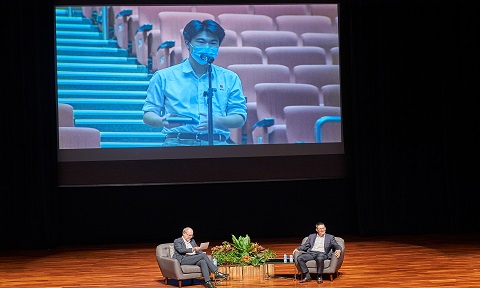
In the back of my mind, I was expecting him to tell me something that I already knew or assumed – that he felt shocked, or surprised, or utterly mesmerised. However, much like the truth that we live in a chaotic universe that, in many ways, is completely unpredictable - his answer was unexpected. His reaction to his discovery went against my expectations. He did not feel shocked when he made such a ground-breaking discovery but instead he felt grateful for what he and the scientists before him had done for humanity. He changed the course of history whereby future generations will use his findings for advancing the scientific community. What I learned in that moment, beyond the insight that he shared about the universe, was that science isn't a quest for glory, it is a simple quest for knowledge. Prof Queloz reminded us as an audience of which I will never forget to be humble.
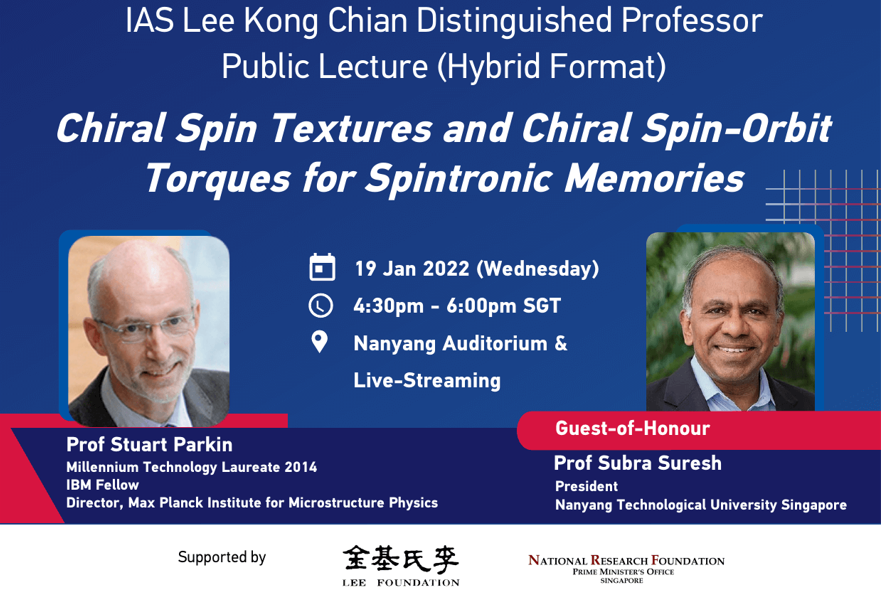
Our distinguished speaker Prof Stuart Parkin is the Director of the Max Planck Institute for Microstructure Physics and Alexander Von Humboldt Professor at Martin Luther University Halle-Wittenberg. His discoveries in spintronics have enabled a more than ten thousand fold increase in the storage of magnetic disk drives. For his work that enabled the “big data” world of today, Prof Parkin was awarded the Millennium Technology Award from the Technology Academy Finland in 2014. He also received the King Faisal Prize 2021 for his research into three distinct classes of spintronic memories.
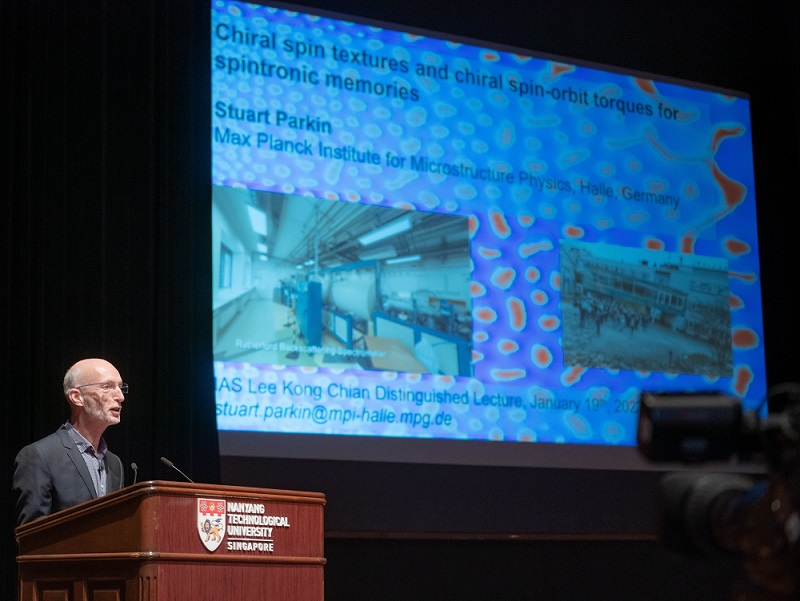
The hybrid format public lecture, held on 19 January 2022 at the Nanyang Auditorium, was organised by the Institute of Advanced Studies at NTU with support from the Lee Foundation and the National Research Foundation, Singapore. The lecture preceded a welcome address from Prof Simon Redfern, Dean, NTU College of Science, and an opening address by the Guest-of-Honor Prof Subra Suresh, NTU President.
From household to industry and from security to ministry, the data is everywhere. This data is stored somewhere or the other on a disk drive. Also, the expansion of the digital world calls for a need to go beyond magnetic disk drives to bring down the size of the device and enhance the speed of data transfer.
In this public lecture, Prof Stuart Parkin addressed the problem which requires state of the art solution and introduced the “Racetrack memory”. The “Racetrack Memory” is based on the latest development in spintronics that turns spinning electrons into small magnetic units to store information. This makes it possible to build data storage devices with greater capacity than hard drives, are a million times faster and require less energy. He further elaborated on the working of this novel storage class memory device which has no moving parts, but works with spin-polarised currents via spin-orbit torques in synthetic antiferromagnetic racetracks.
The lecture underlined that these synthetic antiferromagnetic structures are highly promising for spintronics, especially since this allows for magnetic structures which have zero net magnetisation while simultaneously possessing magnetic surfaces that aid the detection of their magnetic states. The non-volatile Racetrack Memory has the potential to replace the density memories, namely hard-disk and solid-state drives. The lecture was followed by an interactive question and answer session, moderated by Prof Tze Chien Sum, Director, IAS@NTU. Prof Parkin addressed different questions extending from the working principle of novel classes of memories to fundamental physical entities such as skyrmions. A few students also put forward questions concerning efficient research practices and future outlooks.
Arpit Arora | SPMS Graduate Student’s Club
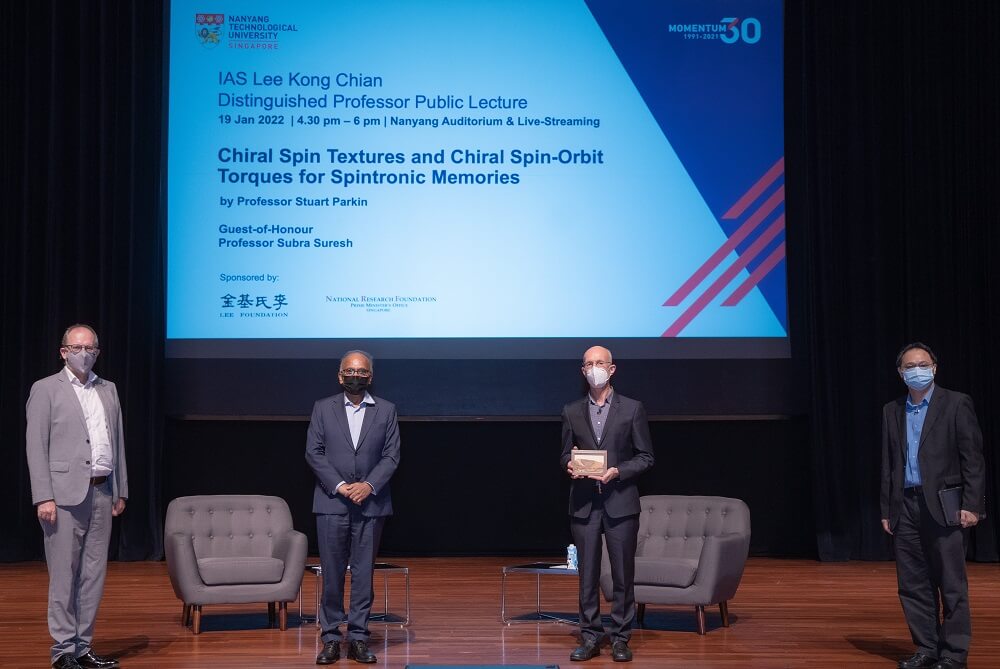 [From left] Dean, NTU College of Science Prof Simon Redfern, NTU President Prof Subra Suresh, Prof Stuart Parkin, and IAS NTU Director Prof Sum Tze Chien
[From left] Dean, NTU College of Science Prof Simon Redfern, NTU President Prof Subra Suresh, Prof Stuart Parkin, and IAS NTU Director Prof Sum Tze Chien

